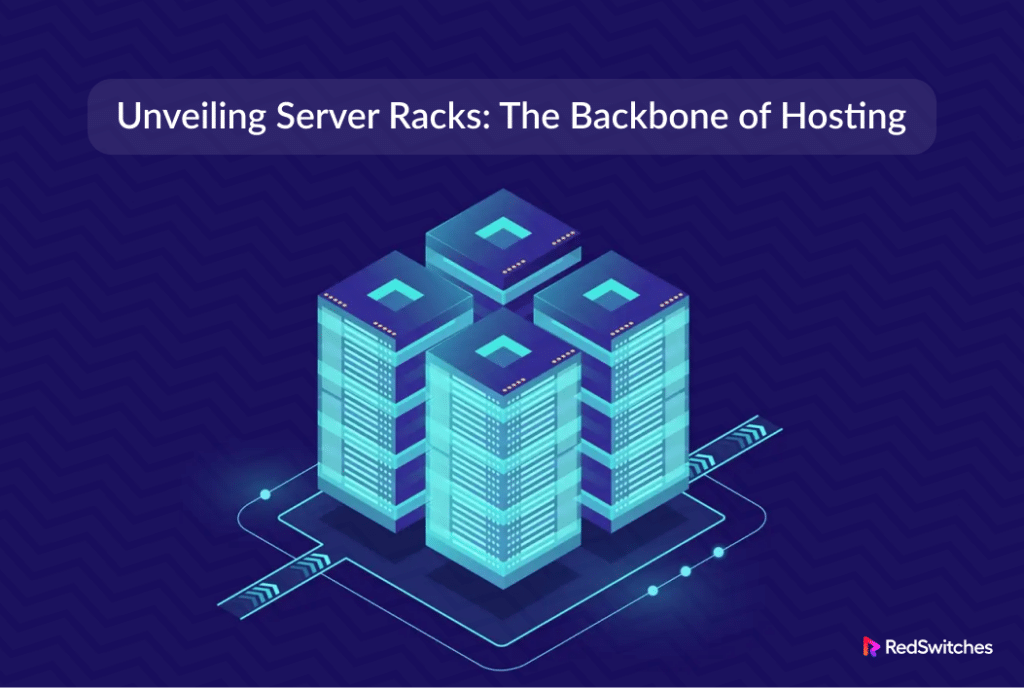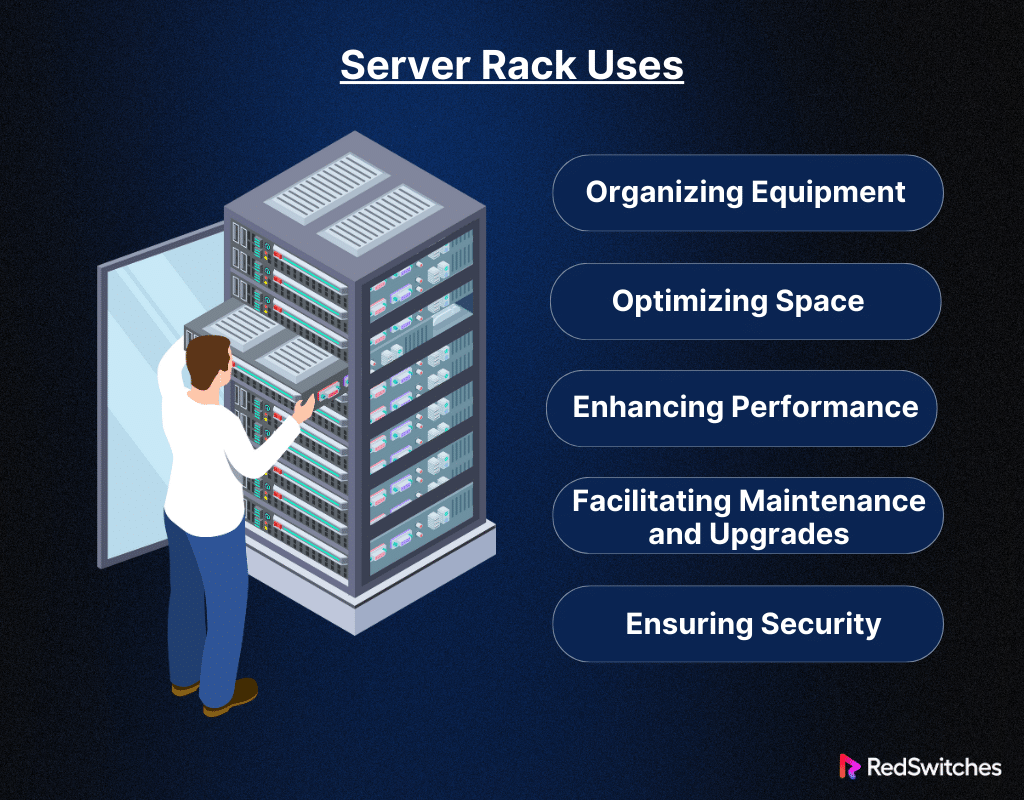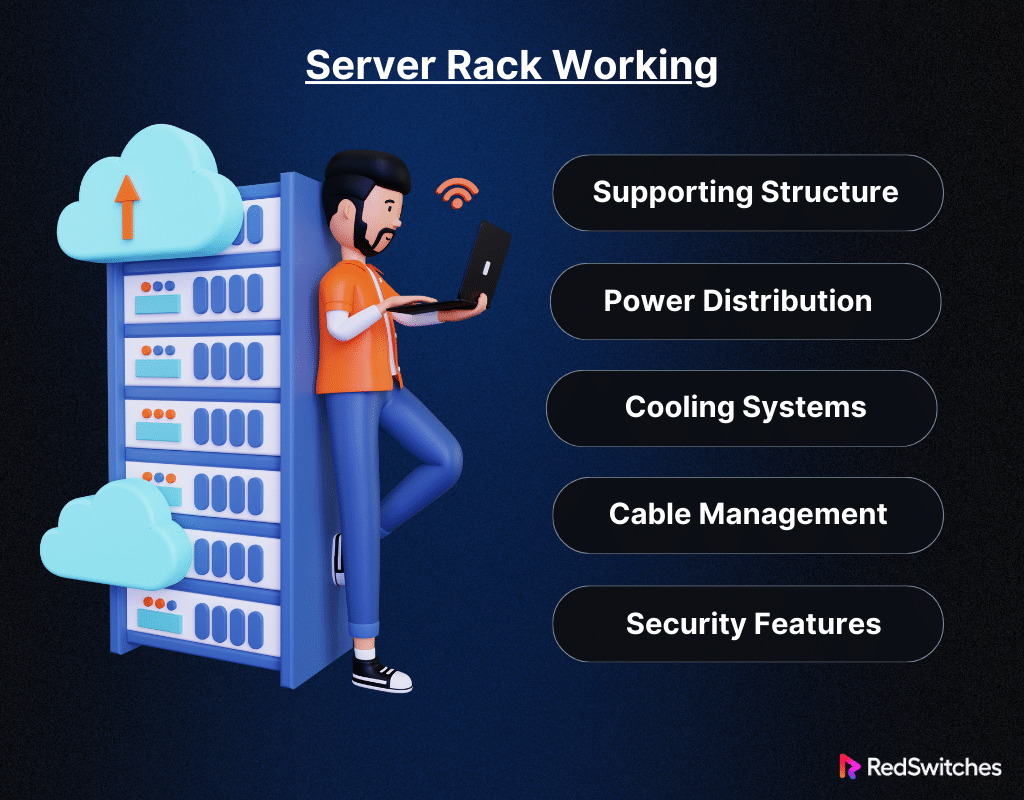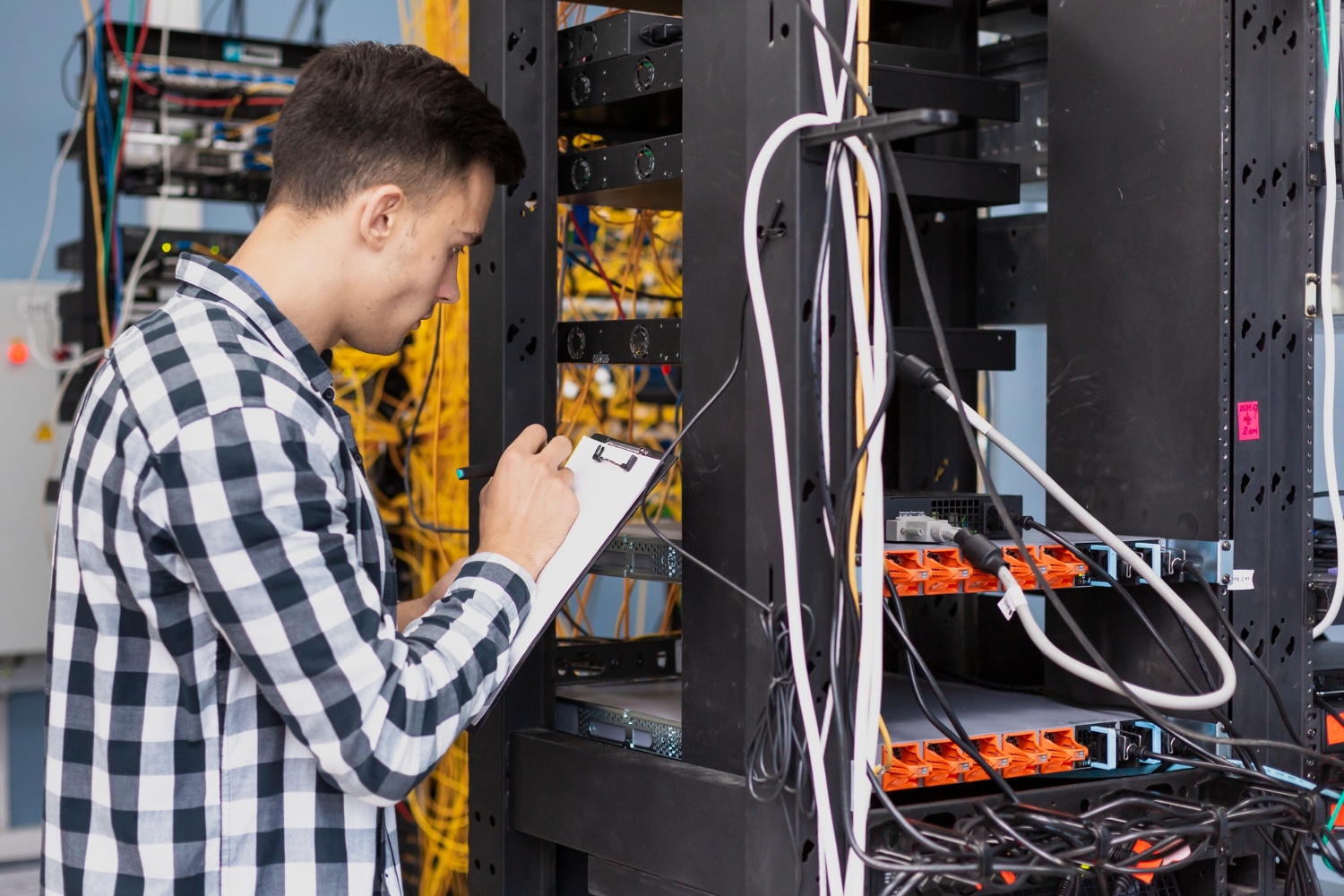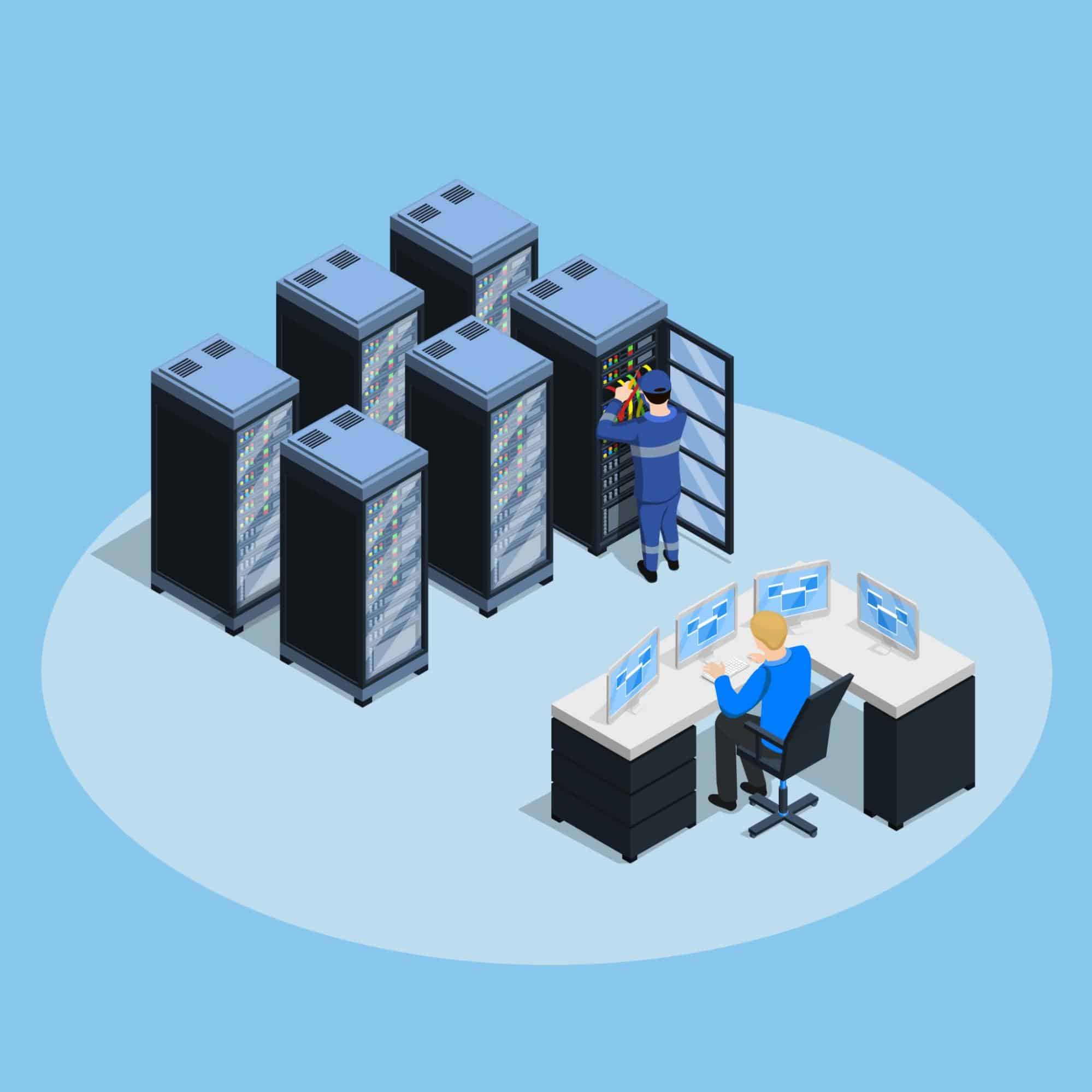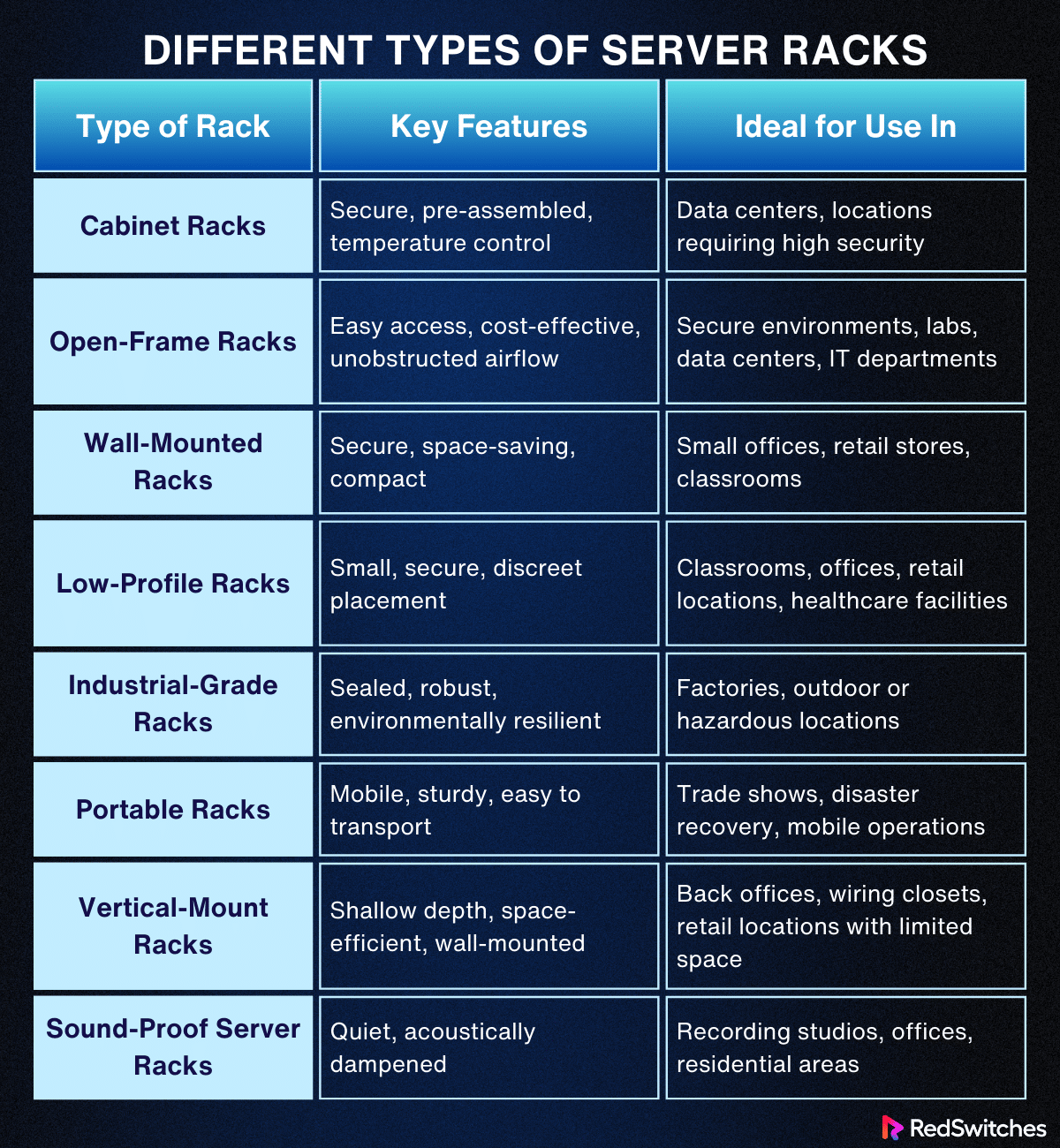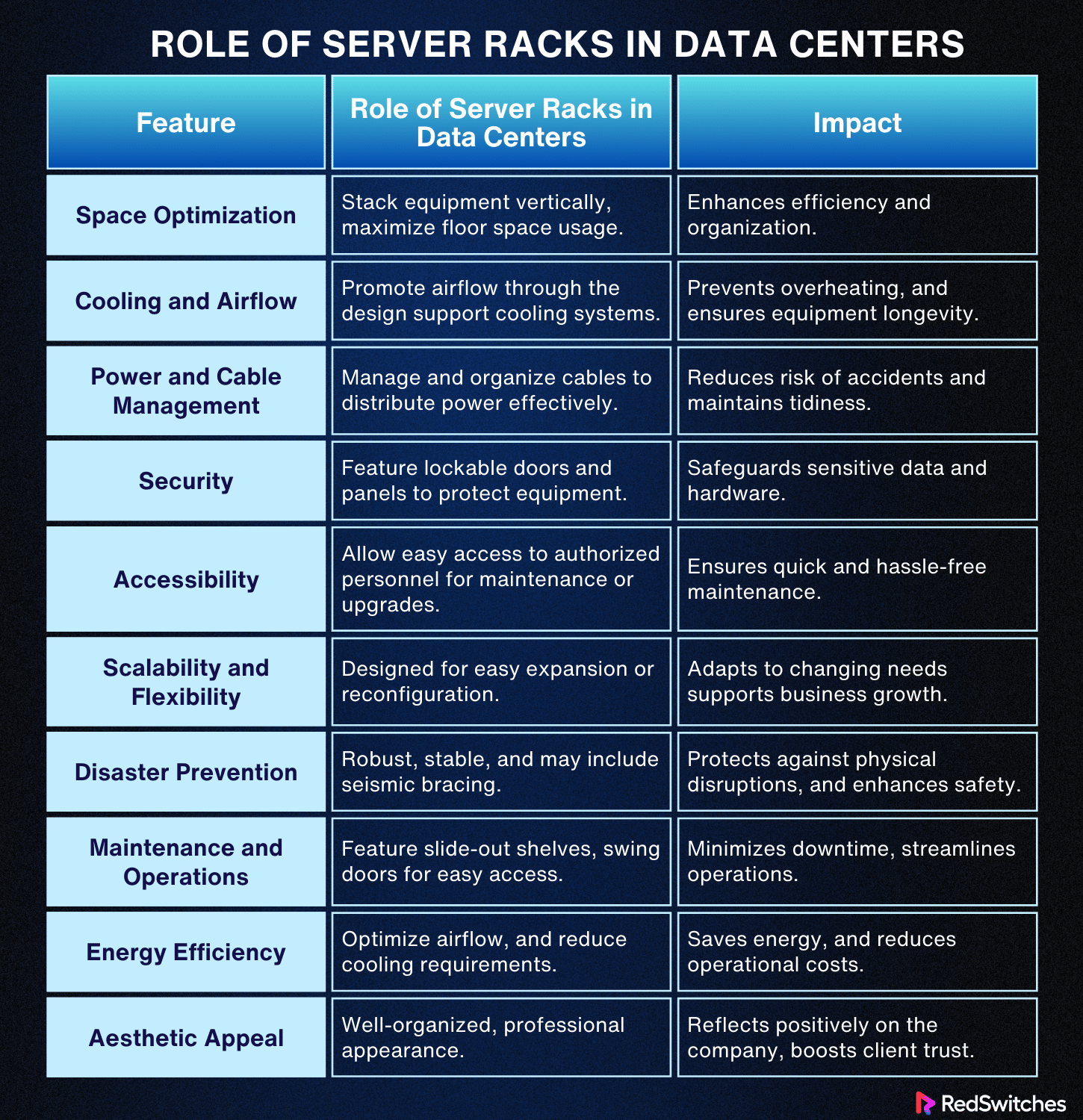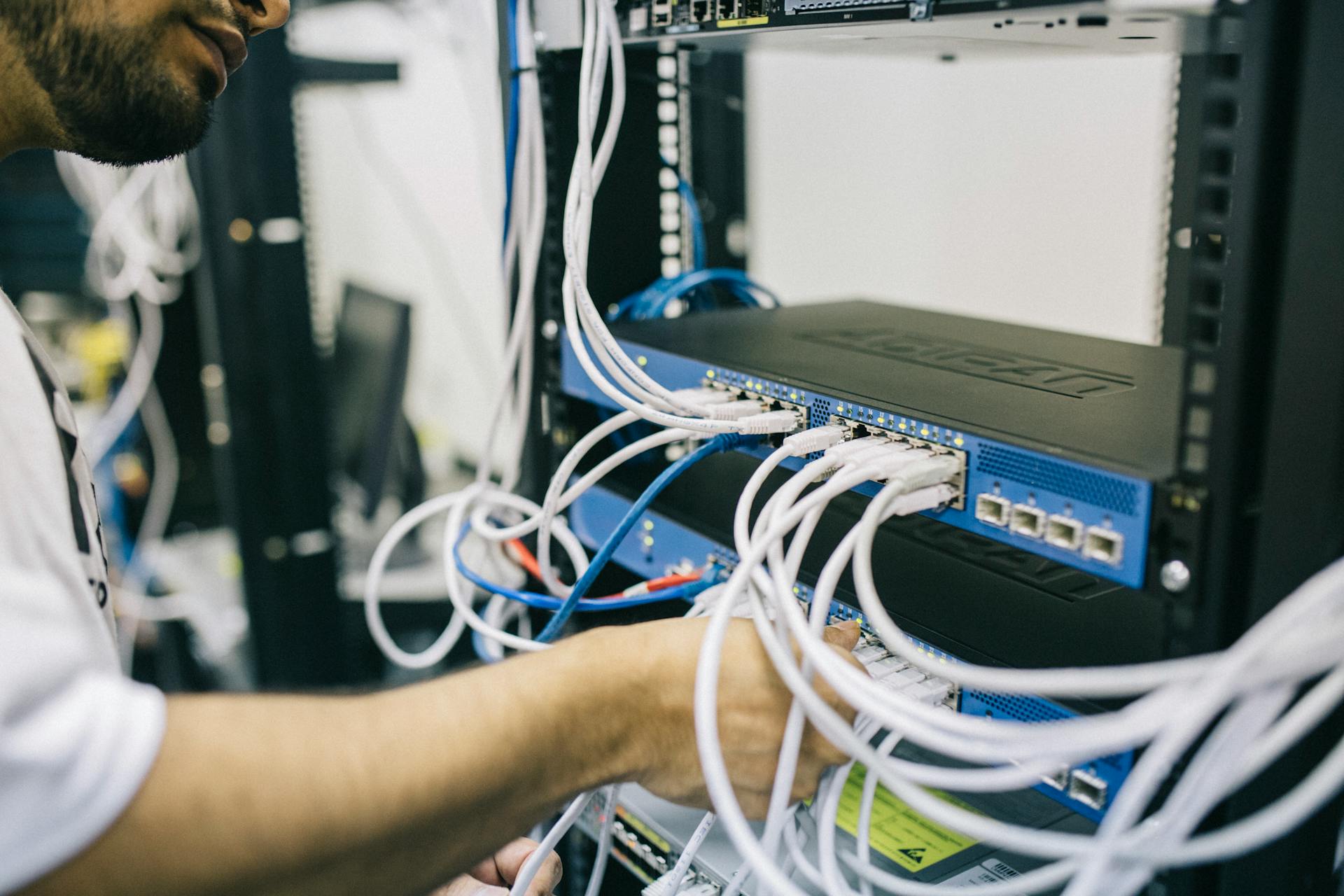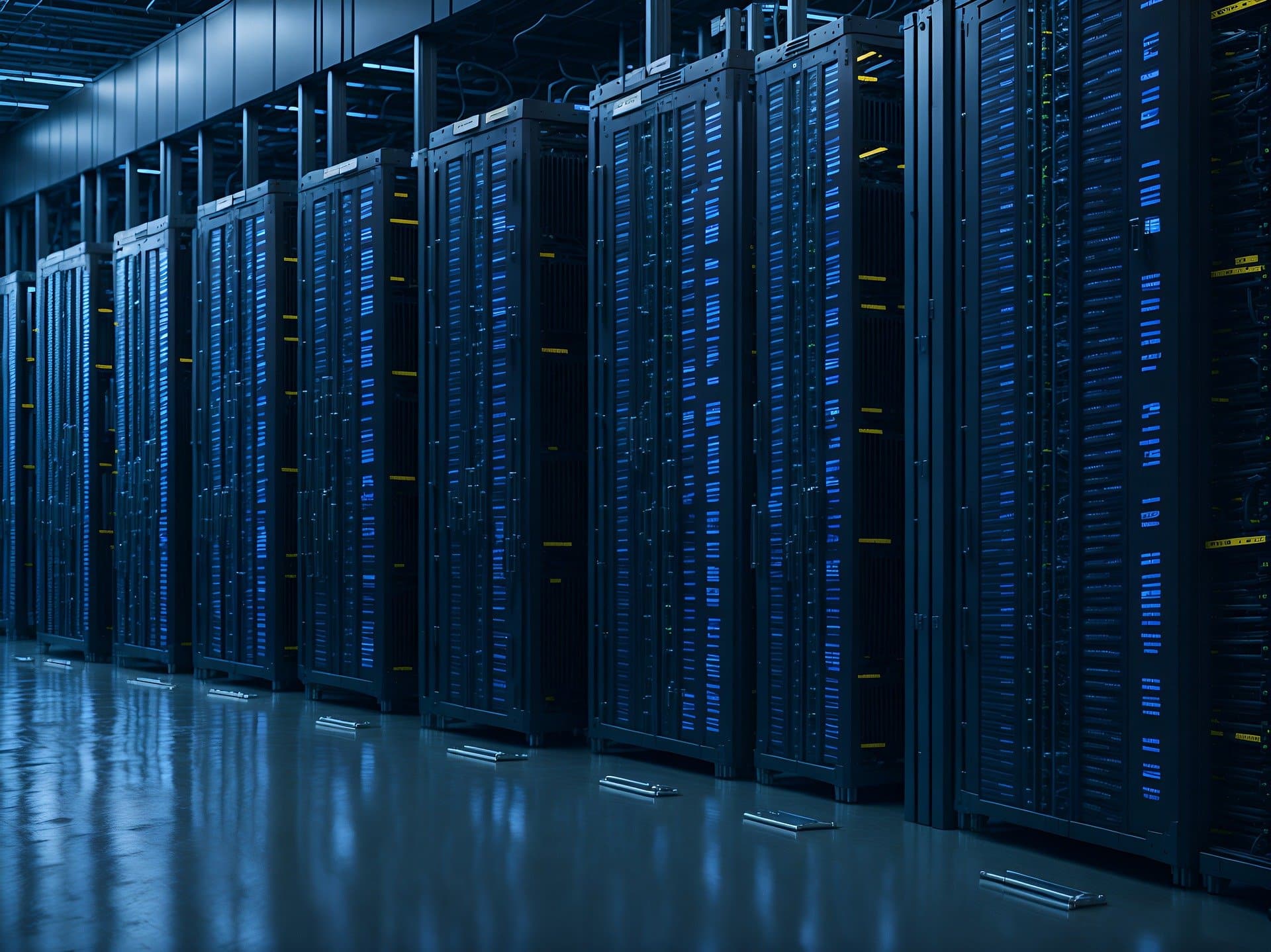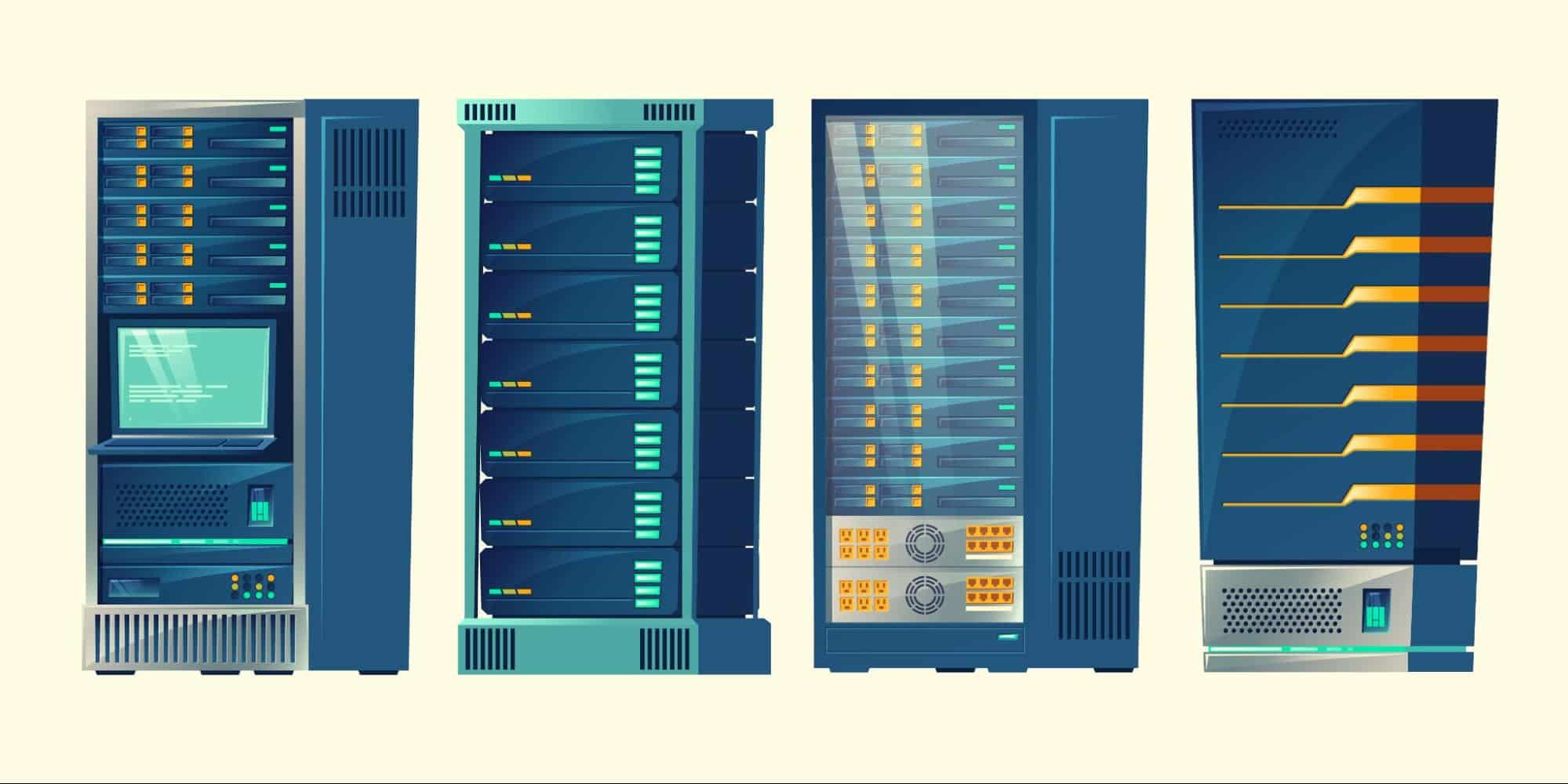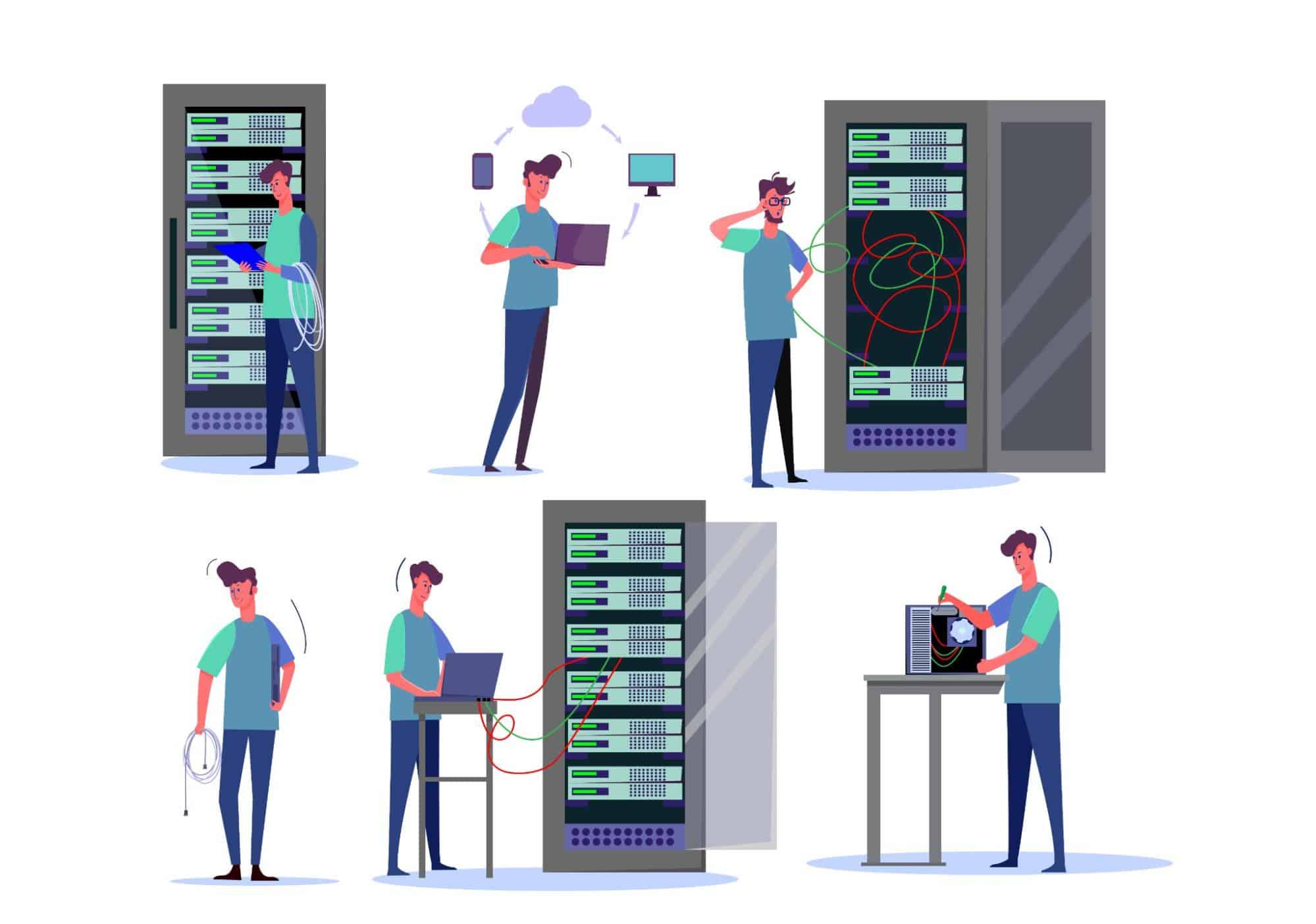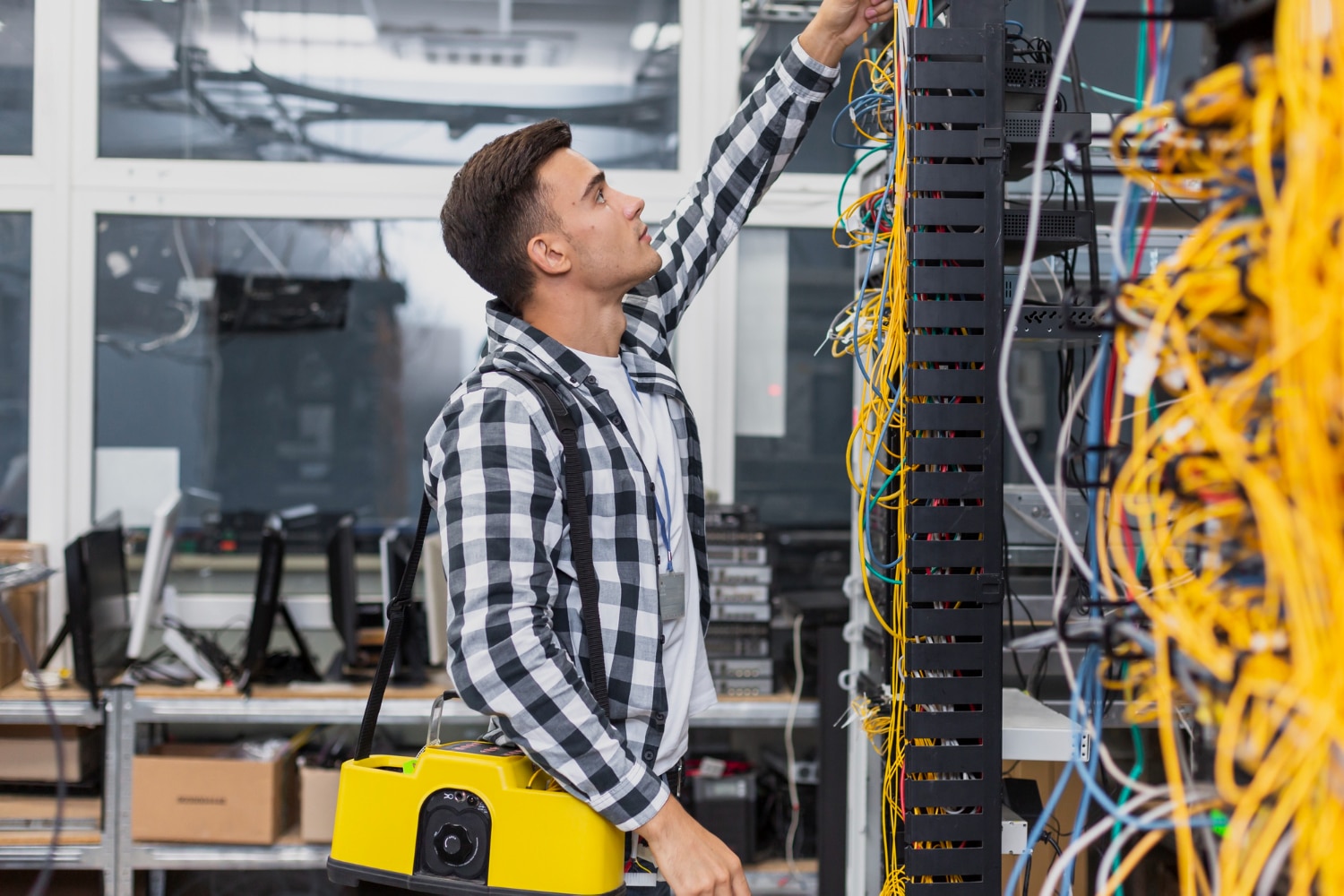Key Takeaways
- Server racks are pivotal for optimizing server performance and ensuring smooth online service operations.
- They provide a supportive framework for IT equipment, integrating power, cooling, and cable management systems.
- Server racks organize IT hardware, enhance performance, facilitate maintenance, and secure equipment.
- They offer sturdy support, power distribution, cooling, cable management, and security for streamlined IT operations.
- Consider factors like size, load capacity, cooling efficiency, and compliance standards when selecting server racks.
- Available in various forms like enclosed cabinets or open-frame racks, each catering to specific needs and environments.
- Server racks are vital for optimizing space, managing power and cables, ensuring cooling, and supporting scalability in data centers.
- Understanding the differences between tower, rack, and blade servers is crucial for selecting based on space, scalability, and power efficiency.
- Choose between server and network racks based on your IT infrastructure’s specific needs for cooling or cable management.
- Pick the right server rack by evaluating equipment needs, cooling, space, and security, and maintain it through regular inspections and updates.
Table of Contents
- Key Takeaways
- What is a Server Rack?
- The Role of Server Racks in Data Centers
- The Importance of Organization and Space Optimization
- Ensuring Cooling and Airflow
- Power Distribution and Cable Management
- Security and Accessibility
- Enhancing Scalability and Flexibility
- The Role in Disaster Prevention
- Streamlining Maintenance and Operations
- Contribution to Energy Efficiency
- The Aesthetic and Professional Appeal
- Tower Server vs. Rack Server vs. Blade Server: What’s the Difference?
- Server Rack or Network Rack?
- Selecting the Right Server Rack Or Cabinet
- Server Rack Size, Depth, Rack Unit (U)
- Conclusion
- FAQs
In the digital age, where the global internet population has surged past 5.3 billion users, the unsung heroes ensuring this massive connectivity are server racks—the backbone of hosting.
These sophisticated structures, often unnoticed, are fundamental in data centers worldwide, quietly supporting the servers that store, process, and manage the colossal amount of data generated every second.
These racks aren’t just metal frames; they’re pivotal in optimizing server performance, enhancing data security, and ensuring the seamless operation of countless online services we depend on daily.
From small businesses running their websites to large corporations managing extensive databases, server racks are indispensable. As we unpack the world of server racks, you’ll discover their critical contribution to keeping our digital world organized and efficient.
What is a Server Rack?
Credits: Freepik
A server rack is a physical steel and electronic framework designed to house servers, networking devices, cables, and other data center computing equipment. This structure is essential in organizing, securing, and providing the necessary infrastructure for these components to operate efficiently. With features designed to accommodate power supplies, cooling systems, and cable management, server racks allow for the high-density arrangement of equipment, making them a cornerstone in any data center or IT environment.
Also Read Difference Between Mainframe and Cloud Computing: 5 Key Areas To Consider
Server Rack Uses
Server racks serve multiple vital functions in data management and IT infrastructure. Primarily, they are used for:
- Organizing Equipment: Server racks provide a standardized framework to mount and organize various IT equipment, ensuring that everything from servers to switches is securely housed and easily accessible.
- Optimizing Space: By accommodating equipment in a vertical, stacked manner, server racks enable data centers to maximize their floor space, an essential factor given the premium nature of data center real estate.
- Enhancing Performance: Server racks are designed with cooling in mind. They promote air circulation, preventing overheating of equipment. This is crucial for maintaining optimal performance and extending the lifespan of the hardware.
- Facilitating Maintenance and Upgrades: With a structured and accessible hardware arrangement, server racks simplify maintenance tasks and hardware upgrades, minimizing downtime and ensuring smooth operations.
- Ensuring Security: Many server racks come with locking mechanisms and robust materials, providing a secure environment to protect sensitive equipment from unauthorized access or accidental damage.
Server Rack Working
Server racks are the framework within which servers and other networking equipment operate. Here’s how they work:
- Supporting Structure: Server racks are made of sturdy materials like steel and are designed to support the weight of servers, networking devices, and other IT equipment. They come in various sizes, commonly measured in rack units (U), where one rack unit equals 1.75 inches in height.
- Power Distribution: They often incorporate power distribution units (PDUs) that supply power to the mounted equipment, ensuring a stable and uninterrupted power supply for the devices.
- Cooling Systems: Server racks are designed to facilitate proper airflow. They may include built-in fans or be configured to work with data center cooling systems like air conditioning units or liquid cooling systems, maintaining an optimal temperature for the equipment.
- Cable Management: With integrated cable management solutions, server racks help in organizing and securing cables, preventing tangling and damage, and ensuring easy access for maintenance or changes in configuration.
- Security Features: Server racks may include locking doors, side panels, and other security features to protect the equipment from unauthorized access and physical threats.
In essence, server racks are more than mere storage solutions. They are meticulously engineered to enhance critical IT assets’ operation, maintenance, security, and overall performance.
Also Read A Day In The Life Of A Data Center Engineer
Features and Specifications
Regarding server racks, many features and specifications are considered to ensure they meet the demands of modern data centers and IT environments. These features and specifications define server racks’ physical and operational characteristics and contribute to their functionality, durability, and adaptability. Here’s a detailed look at the key features and specifications when dealing with server racks:
Credits: Freepik
Size and Dimensions
Height: Often measured in rack units (U), with one rack unit equaling 1.75 inches. Common rack heights include 42U, 48U, and custom sizes.
Width and Depth: Standard widths are typically 19 or 23 inches, with varying depths to accommodate different equipment sizes. Ensuring the rack dimensions align with the space available and the equipment requirements is crucial.
Load Capacity
Weight Support: Racks are rated by the maximum weight they can support, considering the cumulative weight of servers, switches, cooling equipment, and more. Ensuring the rack can handle the load is vital for safety and longevity.
Material and Construction
Build Quality: High-quality materials such as steel or aluminum are used for durability and strength. The choice of material affects the rack’s weight, sturdiness, and environmental resilience.
Design Considerations: Some racks feature modular designs for easy expansion or customization. The construction may also include seismic bracing for racks located in earthquake-prone areas.
Cooling Efficiency
Ventilation: Features like perforated doors or panels, built-in fans, or compatibility with liquid cooling systems ensure proper airflow and cooling, essential for maintaining optimal equipment performance.
Cable Management
Organization Features: Built-in cable management systems, such as vertical or horizontal cable managers, cable ducts, and rings, help in organizing and protecting cables, ensuring a tidy setup and easing maintenance and upgrades.
Accessibility and Security
Doors and Panels: Lockable doors and removable side panels provide secure access to equipment. Options may include transparent doors for visual monitoring without opening the rack.
Mobility: Some racks come with casters for mobility, allowing for easy relocation within the data center.
Compliance Standards
Industry Standards: Compliance with industry standards like EIA/ECA-310 for rack dimensions and design ensures compatibility with a wide range of equipment and accessories.
Additional Features
Sound Dampening: Some racks are equipped with sound-dampening materials to reduce operational noise, ideal for environments where noise is a concern.
Environmental Resistance: Specialized racks may resist dust, moisture, or electromagnetic interference, suitable for harsh or specialized environments.
When selecting a server rack, it’s essential to consider these features and specifications in the context of your specific needs, including the type of equipment to be housed, the operational environment, and any future expansion plans. A well-chosen server rack optimizes the performance and lifespan of your IT equipment and contributes to the overall efficiency and security of your IT operations.
Also Read Cloud Repatriation: Should You Stay Or Move Away From Public Cloud?
Types of Server Racks
Credits: Freepik
In the intricate world of data management and IT infrastructure, server racks are indispensable in ensuring operational efficiency and organization. These structures, tailored for diverse needs and environments, come in various forms. Let’s explore the common types of server racks and their distinctive features.
Server Rack Cabinets (Server Rack Enclosures)
Server cabinets are fully enclosed racks with doors and side panels that can be locked, providing an added layer of security. Their robust design offers enhanced protection for the equipment, making them a staple in data centers or locations where safeguarding equipment is paramount.
Key Features: High security, pre-assembled, conducive to controlled airflow and temperature management.
Open-Frame Racks (2-post and 4-post racks)
Open-Frame Racks (2 post and 4 post racks) are characterized by their lack of doors or side panels, offering fast and unimpeded access to equipment and cabling. Their open design promotes efficient airflow, making them suitable for secure, well-ventilated environments.
Key Features: Easy equipment access, cost-effective, excellent for environments where security is not a primary concern.
Wall-Mounted Racks
Designed to be affixed directly onto walls, these racks are compact and secure, optimizing space usage in areas with limited floor availability. They are prevalent in network closets and small spaces.
Key Features: Space-efficient, secure, ideal for compact spaces and smaller equipment setups.
Low-Profile Racks
These racks are smaller and designed to fit in non-IT environments where space is constrained, such as classrooms, retail locations, offices, and healthcare facilities.
Key Features: Compact size, secure, suitable for environments with limited space and a need for discreet server placement.
Industrial-Grade Racks
Built for resilience and durability, these racks are tailored for specific types of equipment or challenging environments like factories, outdoor settings, or hazardous locations.
Key Features: Robust, sealed against environmental factors, ensuring the safety and functionality of equipment in demanding conditions.
Portable Racks
Equipped with casters for mobility, these racks are designed for scenarios where equipment needs to be mobile, offering flexibility and convenience for transient or mobile setups.
Key Features: Mobile, sturdy, perfect for temporary setups or events like trade shows, or in disaster recovery situations.
Vertical-Mount Racks
These are wall-mounted racks with a vertical orientation, minimizing depth and maximizing space efficiency. They are optimal for back offices, wiring closets, or retail locations with limited horizontal space.
Key Features: Space-saving with a shallow depth, wall-mounted, ideal for environments with severe space restrictions.
Sound-Proof Server Racks
Specifically designed to mitigate IT equipment’s noise, such as recording studios, offices, or residential areas, are used to maintain a quiet environment.
Key Features: Acoustically dampened, minimizing noise output from servers and network equipment.
Choosing the right server rack type hinges on understanding the specific requirements of your IT environment, including space constraints, security needs, accessibility, and the nature of the equipment housed. Each rack type offers unique features and benefits, making it crucial to assess your needs meticulously before selecting.
Also Read Different Types of Servers: Understanding Server Types for Enhanced Functionality
Here’s a summarized table showcasing the different types of server racks, their key features, and ideal use-cases:
The Role of Server Racks in Data Centers
Server racks are much more than simple storage solutions for IT equipment; they are integral to the functionality, efficiency, and security of data centers. Understanding the multifaceted role of server racks in these environments highlights their importance in managing and safeguarding the technological backbone of modern businesses. Here are the key roles that server racks play in data centers:
The Importance of Organization and Space Optimization
Data centers are the brains of the internet, handling tons of data every second. To manage this, they need a lot of servers and equipment. However, space is expensive, and wasting it is not an option. That’s where server racks come in. They stack equipment vertically, ensuring every inch of floor space is used effectively. Plus, having a well-organized rack makes maintenance and upgrades much more straightforward. Technicians can easily locate and work on the specific device they need without disrupting the others.
Credits: Pexels
Ensuring Cooling and Airflow
Servers work non-stop and generate a lot of heat. If this heat is not managed properly, it can lead to equipment failure. Server racks are designed to promote airflow, helping to keep the equipment cool. They have perforated doors and panels that allow air to flow through the rack, carrying away the heat. In a well-designed data center, the layout of the racks is planned to maximize cooling efficiency, often using hot aisle/cold aisle arrangements. This setup ensures that cool air reaches the servers and the hot air is efficiently expelled.
Power Distribution and Cable Management:
Imagine the number of cables and power cords a single server needs. Now multiply that by the hundreds or thousands of servers in a data center. It sounds like a recipe for chaos, but server racks keep it all under control. They have features for managing and organizing cables and power distribution units (PDUs). This keeps the area tidy and reduces the risk of accidents or unplugging something important while moving around.
Also Read Cracking the Server Code: Understanding Server Machines
Security and Accessibility
Data centers hold sensitive information, and security is a top priority. Server racks often have lockable doors and panels to protect the equipment from unauthorized access. At the same time, they are designed to be easily accessible to authorized personnel for maintenance or upgrades, ensuring that any necessary work can be done quickly and without hassle.
Enhancing Scalability and Flexibility
As businesses grow and technology evolves, the needs of a data center can change rapidly. Server racks are designed with scalability in mind, allowing for easy expansion or reconfiguration. This means when a company needs to add more servers or upgrade existing ones, it can be done without a major overhaul of the entire system. Modular designs and adjustable mounting rails ensure that server racks can accommodate equipment of different sizes and shapes, providing flexibility and future-proofing the data center.
The Role in Disaster Prevention
In a world where data is one of the most valuable assets, protecting it from disasters is crucial. Server racks play an unexpected yet vital role in this aspect. They are engineered to be robust and stable, ensuring the equipment remains secure even in adverse conditions. Features such as seismic bracing make racks resistant to vibrations and earthquakes.
Credits: Freepik
Furthermore, the organized layout of server racks aids in fire prevention and suppression. Ensuring proper airflow and preventing overheating significantly reduces the risk of fire. In case of a fire, the clear and organized layout allows for quicker and more effective responses.
Streamlining Maintenance and Operations
Routine maintenance is a part of the life cycle of any technological equipment. Server racks simplify this process. With features like slide-out shelves and swing doors, technicians can access the equipment easily. This minimizes the downtime during maintenance or upgrades.
Moreover, well-organized racks prevent accidental disconnections or disruptions, ensuring routine operations continue smoothly even during maintenance activities.
Contribution to Energy Efficiency
Data centers consume significant energy, and making them more energy-efficient is a constant goal. Server racks contribute to this by optimizing airflow and reducing the cooling requirements. When servers are arranged systematically, cooling systems can work more efficiently, saving energy significantly.
Additionally, with advanced cable management, there’s less clutter, reducing dust buildup and improving cooling efficiency.
The Aesthetic and Professional Appeal
Lastly, while functionality is the primary concern, server racks’ aesthetic and professional appeal can’t be ignored. A well-organized, clean, and professional-looking data center reflects positively on the company. It shows a commitment to quality and reliability, which can be crucial for businesses that host client data or provide IT services.
In conclusion, server racks might seem like simple metal frames, but they are crucial in data centers’ efficient, safe, and organized operation. They maximize space, promote cooling, manage cables, distribute power, and secure the equipment, all of which are essential for the smooth operation of the data centers that keep our digital world running.
Also Read How to Check Server Location? A Step-By-Step Guide
This table encapsulates the multifaceted role of server racks in data centers, highlighting their impact on various operational, safety, and efficiency aspects.
Tower Server vs. Rack Server vs. Blade Server: What’s the Difference?
In dedicated servers, the physical form factor is pivotal in determining the server’s functionality, scalability, and suitability for specific tasks. Tower servers, rack servers, and blade servers are the three primary types of servers, each with unique characteristics and advantages. Understanding the differences between these servers can guide businesses in making informed decisions tailored to their specific IT needs.
Credits: Pixabay
Tower Servers
Tower servers resemble the look of a traditional desktop PC but are more powerful. They stand upright and can be used without any special mounting hardware.
-
Advantages:
- Versatility: They can be placed in any office environment without needing a dedicated server room.
- Expandability: Tower servers generally have more room for expansion, making them suitable for businesses anticipating gradual IT requirements growth.
- Cooling Efficiency: Their standalone design allows for better airflow, reducing the need for advanced cooling systems.
- Ideal Use: Small businesses or organizations with limited space that require a dedicated server without the complexities of an extensive network infrastructure.
Rack Servers
Rack servers are designed to be installed in a framework called a rack, which can hold multiple servers stacked on top of each other, optimizing space and centralizing resources.
-
Advantages:
- Space-saving: By stacking servers vertically, rack servers minimize the physical footprint of the hardware.
- Scalability: They allow for easy expansion by adding more servers to the rack as needed.
- Centralized Management: Rack servers simplify cable management, power distribution, and network connectivity, making them easier to manage.
- Ideal Use: Medium to large businesses that require multiple servers, offering a balance between space-saving and performance, making them a favored choice for dedicated server hosting in data centers.
Blade Servers
Blade servers are even more streamlined than rack servers. They consist of thin, modular electronic circuit boards known as server blades, each housing a server stripped down to its core processing components.
-
Advantages:
- High Density: Blade servers offer the highest processing power density, optimizing space and resources in large-scale data center environments.
- Reduced Power Consumption: Sharing power, cooling, and networking components across multiple blades makes them more energy-efficient.
- Simplified Infrastructure: Blade servers reduce wiring complexity with shared components, making them easier to manage and scale.
- Ideal Use: Large enterprises or data centers where space and power efficiency are paramount and the need for processing power is high. They are well-suited for businesses that require a high density of dedicated servers.
In choosing between tower, rack, and blade servers, businesses must consider factors such as space availability, scalability needs, power efficiency, and the specific requirements of their server applications. Each type offers distinct advantages, and the best choice will depend on the unique needs and resources of the business.
Also Read Physical Server vs Virtual Server: 5 Key Differences Explained
Server Rack or Network Rack?
In the architecture of data centers and IT environments, the distinction between server racks and network racks is subtle yet significant, especially when organizing and managing dedicated servers and network equipment. While both types of racks serve the essential purpose of housing and protecting IT equipment, understanding their specific functionalities and best use cases is crucial for optimizing your IT infrastructure.
Credits: Freepik
Server Rack
Server racks are designed to house servers, including dedicated servers, storage systems, and other data center computing equipment. They are typically built to support heavier equipment and facilitate servers’ high power and cooling requirements.
-
Characteristics:
- Robust Build: They are generally sturdier to support the weight and operations of heavy-duty servers.
- Enhanced Cooling: Server racks are designed with cooling efficiency in mind, accommodating the substantial heat output of servers with features like perforated doors or advanced cooling systems.
- Depth: Server racks are usually deeper than network racks to accommodate the length of server hardware, providing ample space for cabling and airflow.
- Ideal Use: Server racks are ideal for data centers and businesses where the primary need is housing high-performance dedicated servers and computing equipment, ensuring optimal operation, cooling, and maintenance.
Network Rack
Network racks, on the other hand, are geared towards housing network equipment such as switches, patch panels, routers, UPS systems, and network cabling. They are structured to facilitate easy access to cables and networking hardware.
-
Characteristics:
- Accessibility: Network racks often have an open frame design to access cables and networking components easily.
- Shallower Depth: Unlike server racks, network racks are not as deep since networking equipment generally requires less space.
- Cable Management: They have features tailored for extensive cable management, ensuring an organized and accessible setup.
- Ideal Use: Network racks are best suited for environments where the primary focus is on network connectivity and communication rather than high-density computing power. They are typically used in server rooms, IT offices, or areas where network cabling and distribution are centralized.
When deciding between a server rack or a network rack for your dedicated server and IT infrastructure needs, consider the type of equipment you’ll be housing, the importance of accessibility versus security, and the specific requirements for power, cooling, and cable management. The choice will significantly impact your IT operations’ efficiency, scalability, and manageability.
Also Read What is Server Clustering & How Does it Work? + 3 Main Benefits
Selecting the Right Server Rack Or Cabinet
Choosing the right server rack is a critical decision that can influence your IT infrastructure’s efficiency, scalability, and reliability, especially when housing dedicated servers and other crucial equipment. A well-chosen server rack ensures your hardware’s safe and organized housing and enhances your IT assets’ performance and longevity. Here are detailed considerations to guide you in selecting the ideal server rack:
Credits: Freepik
Assess Your Equipment Requirements
- Size and Dimensions: Ensure the rack dimensions can accommodate your current equipment and allow for future expansion. Consider the height (in rack units), width, and depth of your servers, storage devices, and network equipment.
- Weight Capacity: Check the weight capacity of the rack. It should support the cumulative weight of all the equipment, including servers, power supplies, cooling systems, and other accessories.
Consider Cooling and Airflow
- Cooling Systems Compatibility: Choose a rack that supports your cooling strategy, whether it’s active cooling (with fans or air conditioning) or passive cooling (through natural airflow). Ensure there are provisions for proper ventilation to prevent overheating.
- Airflow Management: Look for features that enhance airflow, such as perforated doors, vented panels, and cable management solutions that prevent obstruction of air circulation.
Evaluate Space and Scalability
- Data Center or Room Space: Consider the physical space where the rack will be located. Ensure enough room for door opening, airflow, and maintenance access.
- Scalability: If you anticipate future growth, opt for a rack that offers scalability, allowing for additional racks or integrating expansion modules.
Focus on Accessibility and Security
- Ease of Access: Choose a rack that provides convenient access for installation, maintenance, and upgrades. Features like removable side panels, doors that open 180 degrees, and tool-less mounting can be beneficial.
- Security Features: If security is a concern, consider racks with lockable doors and side panels. Assess the robustness of the locking mechanisms and the overall build quality for protecting sensitive equipment.
Pay Attention to Cable Management
- Cable Management Solutions: Efficient cable management is crucial for organization and accessibility. Opt for racks with built-in cable management features like vertical and horizontal cable managers, cable ducts, and cable entry points.
Consider Compliance and Standards
- Industry Standards: Ensure the rack meets relevant industry standards and regulations, especially if you’re in a sector that requires specific compliance measures.
Assess Additional Features
- Sound Dampening: If the server rack will be located near workspaces, consider soundproof racks to minimize noise.
- Mobility: Consider racks with casters or wheels for environments where the rack needs to be moved occasionally.
- Environmental Resistance: If the rack will be placed in harsh environments, look for racks with additional protection against dust, moisture, or electromagnetic interference.
Budget and Brand Reputation
- Cost Considerations: While it’s important not to compromise on quality, consider your budget and compare the cost-effectiveness of different options.
- Manufacturer Reputation: Choose a reputable brand known for quality, durability, and customer support.
Selecting the right server rack involves carefully assessing your current and future needs, your IT equipment’s specific requirements, and your setup’s environmental conditions. Considering these detailed factors, you can ensure that your investment in a server rack contributes positively to your IT infrastructure’s organization, performance, and growth.
Also Read Selecting the Best DNS Server for Unbeatable Gaming Experiences
Server Rack Size, Depth, Rack Unit (U)
When selecting a server rack, understanding the dimensions and unit measurements is essential to ensure compatibility with your IT equipment and the designated space in your environment. Here’s a detailed breakdown of these key considerations:
Credits: Freepik
Size and Rack Unit (U)
Rack Unit (U): The height of server racks and the equipment housed within them is typically measured in rack units (U), with one rack unit equivalent to 1.75 inches. This standard measurement helps determine how much equipment can fit in a rack. For example, a 42U rack can accommodate equipment that totals up to 42 rack units in height.
Height Consideration: Choose a rack height that accommodates your current equipment and allows for future expansion. Standard rack heights include 24U, 42U, and 48U, but they can range from smaller sizes to over 50U for large installations.
Width and Depth
Standard Width: The industry standard for rack width is 19 inches, with 23 inches being another common size, particularly for telecommunications equipment. Ensure the width supports the mounting requirements of your equipment.
Depth: Rack depth is crucial for accommodating the length of your servers and other equipment. It’s important to consider not just the size of the equipment but also the need for airflow, cable management, and the space required for connectors at the back of the equipment. Racks typically range in depth from 24 inches to 48 inches or more.
Adjustability
Adjustable Rails and Shelves: Some racks offer adjustable mounting rails or shelves, allowing you to modify the depth to suit different equipment sizes. This feature adds flexibility and adaptability to your setup.
Industry Standards
Adherence to industry standards ensures compatibility between your server rack and a wide range of IT equipment, facilitating upgrades, maintenance, and expansion. Here are key standards to consider:
EIA/ECA-310
The Electronic Industries Alliance (EIA) standard EIA/ECA-310 specifies the standard rack sizes, including height (rack units), width, and rack hole placement. It ensures that equipment from different manufacturers can be mounted in the same rack.
Importance: Compliance with EIA/ECA-310 guarantees that your rack can accommodate equipment from various vendors, providing flexibility and ease in configuring your IT setup.
ANSI/TIA-942
This standard provides guidelines for telecommunications infrastructure in data centers. It covers aspects such as rack placement, cabling, and cooling.
Importance: Adherence to ANSI/TIA-942 ensures that your data center’s infrastructure meets performance, scalability, and reliability requirements.
UL Certification
Underwriters Laboratories (UL) certification indicates that the rack meets stringent safety standards.
Importance: UL certification assures the rack’s safety regarding material quality, structural integrity, and fire resistance.
Choosing a server rack with the right size, depth, and compliance with industry standards is vital for creating a safe, efficient, and scalable IT environment. It ensures that your dedicated servers and network equipment are securely housed, adequately cooled, and easily accessible for maintenance and upgrades.
Server Rack Installation and Maintenance
In the realm of data center and IT infrastructure management, the pivotal role played by server racks is undeniable. These structures are not just physical frames but are instrumental in ensuring the efficient operation, optimal airflow, and effective organization of network equipment. This guide delves into the nuanced processes of installing and maintaining server racks, providing you with a roadmap to enhance the operational efficiency of your IT environment.
Credits: Freepik
Also Read How Dedicated Servers Work: A Deep Dive Into Server Functionality
Installation of Server Racks
Installing server racks is a critical step in setting up a data center or server room. Here’s a general guide on how to install server racks:
Planning and Layout
Before the physical installation, meticulous planning is essential. Assess the space allocated for the server racks, paying close attention to factors like ventilation, accessibility for maintenance, and space for future expansion. It’s also crucial to select racks that meet your specific needs in size, weight capacity, and compatibility with your equipment.
Assembling the Racks
Once the planning phase is complete, the next step is assembling the racks according to the manufacturer’s guidelines. Precision and caution are key to ensuring the racks are level, stable, and ready to support your valuable equipment.
Positioning and Securing:
Carefully position the racks in their designated spots after assembly. Consider factors like airflow and ease of access for maintenance. To ensure safety and stability, securely anchor the racks to the floor, especially in areas prone to movement or vibration.
Installing the Equipment:
Begin the equipment installation process by placing the heaviest components at the bottom of the rack. This not only aids in maintaining a low center of gravity for stability but also facilitates easier access for maintaining lighter, frequently adjusted components placed higher up. To promote proper airflow and prevent dust accumulation, use blanking panels to cover any unused rack space.
Maintenance of Server Racks
Regular maintenance of server racks is essential to ensure optimal performance, prevent equipment failure, and extend the lifespan of your hardware. Here’s a general guide on server rack maintenance:
Regular Inspection
Routine checks are vital to identify and address potential issues like loose fittings or blocked air vents before they escalate. This proactive approach aids in maintaining the optimal performance of the equipment housed in the racks.
Cleanliness and Airflow Management
Ensuring that the server racks and the surrounding area are clean and free from dust contributes significantly to maintaining the equipment’s performance and longevity. Proper airflow management, facilitated by well-planned rack layouts and blanking panels, is crucial to prevent overheating and ensure efficient cooling.
Cable Management
Organized and properly labeled cables make maintenance easier and minimize the risk of airflow obstruction and overheating. Employ cable management solutions like racks with built-in channels or separate cable management accessories.
Regular Updating of Rack Layouts
As your IT infrastructure evolves, so should your rack layouts. Regularly reassess and reorganize your server racks to accommodate new equipment, ensuring the setup remains efficient, safe, and scalable.
By following these guidelines for installing and maintaining server racks, you can significantly enhance the efficiency and longevity of your IT infrastructure. Remember, a well-organized, securely installed, and meticulously maintained server rack setup is pivotal to a robust IT environment.
Conclusion
In the dynamic world of IT, the importance of a well-organized, securely housed, and efficiently managed IT infrastructure cannot be overstated. Server racks are pivotal in achieving this, providing the backbone for housing your dedicated servers and networking equipment. From meticulous installation planning to the diligent practices of ongoing maintenance, the efforts invested in managing your server racks translate directly into your IT operations’ reliability, performance, and longevity.
As we’ve navigated through the intricacies of server racks, it’s evident that they are more than mere metal structures. They are the unsung heroes, safeguarding your dedicated servers and ensuring your digital operations run smoothly and efficiently. Whether setting up a new data center, upgrading your current infrastructure, or ensuring that your operations are as efficient as possible, choosing the right server rack and maintaining it properly cannot be understated.
At RedSwitches, we understand the critical role that server racks play in your IT ecosystem. We are committed to providing solutions that meet the unique needs of your business, ensuring that your dedicated servers operate in an environment that is secure, efficient, scalable, and future-proof. With our expertise and support, you can confidently take your IT infrastructure to the next level.
Embark on your journey to a more organized, secure, and efficient IT infrastructure with RedSwitches.
Let us help you find the perfect dedicated servers rack solutions that align with your dedicated server needs and drive your business forward. Explore your options with RedSwitches today.
FAQs
Q. What do you need a server rack for?
A server rack is used to securely house and organize IT equipment such as dedicated servers, network devices, and related accessories, ensuring efficient use of space, improved airflow for cooling, and easier maintenance and scalability.
Q. What are the different types of server racks?
Server racks come in various types, including wall mount racks, 4-post racks, 2-post racks, open frame racks, and enclosed racks. Each type serves a different purpose and caters to specific needs regarding space, installation, and security.
Q. What is the difference between a rack mount and a wall mount server rack?
A rack mount server rack is designed to be installed on the floor or in a data center, while a wall mount server rack is meant to be mounted on a wall, providing a space-saving solution for smaller environments.
Q. What does the “U” mean in 12U or 42U rack measurements?
The “U” stands for rack unit and measures the vertical space in a rack. One rack unit is equal to 1.75 inches (44.45 mm) in height, and the number before the “U” indicates the amount of rack space available for equipment.
Q. What is the maximum load capacity of a server rack?
The load capacity of a server rack varies depending on its design and construction. It is important to check the manufacturer’s specifications to ensure that the rack can support the weight of the installed equipment.
Q. What are the important features when choosing a server rack?
When selecting a server rack, factors such as size, mounting options, ventilation, cable management, and security should be considered to ensure the best fit for the specific networking environment.
Q. How do I determine the appropriate rack depth for my server equipment?
To determine the necessary rack depth for your server equipment, measure the depth of the equipment and add extra space for cable management and airflow. It is crucial to ensure that the chosen rack can accommodate the depth of the installed hardware.
Q. What are the benefits of using an open-frame server rack?
Open-frame server racks provide easy access to equipment, excellent airflow, and flexibility for cable management. They are commonly used in networking environments where quick installation and accessibility are essential.
Q. Are there specific racks designed for network equipment?
Yes, there are specialized network racks or cabinets that are tailored to accommodate networking equipment such as switches, routers, and patch panels. These racks are designed with features to support networking infrastructure requirements.
Q. What are the differences between a 4 post and a 2 post server cabinet?
A 4 post server cabinet is more stable and suitable for heavy equipment, while a 2 post server cabinet is often used for lighter network and telecom equipment.
Q. What does 1U mean in the context of server racks?
1U refers to a unit of measurement for the height of rack-mounted equipment. It is equal to 1.75 inches or 44.45 millimeters.
Q. What is a 12U wall mount server rack?
A 12U wall mount server rack is a compact and space-saving rack mounted on a wall to store and organize equipment without taking up floor space.
Q. What is a 6U adjustable depth rack?
A 6U adjustable depth rack provides the flexibility to customize the depth of the rack to accommodate various equipment sizes and requirements.
Q. What is the purpose of a rack rail in a server rack cabinet?
A rack rail supports and mounts rack-mounted equipment securely within the server rack cabinet, ensuring proper alignment and stability.
Q. What is the significance of 19 inch in the context of server racks?
The 19-inch measurement refers to the standard width of rack-mounted equipment, allowing for compatibility and interchangeability of devices within the server rack cabinet.
